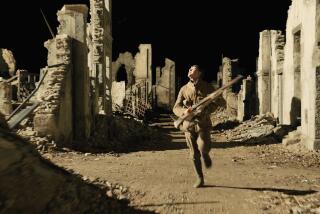William T. Vollmann’s adventures in Afghanistan

- Share via
In 1982, five years before the release of his first novel, “You Bright and Risen Angels,” William T. Vollmann wrote “An Afghanistan Picture Show,” a book about his efforts to help the mujahedin fight Soviet aggression in Afghanistan. He was young — 23 — and inexperienced, and the manuscript he produced would not be published for a decade, but still it tells us something about how he saw, and continues to see, the world.
“My original goal in writing it,” he told the Paris Review in 2000, “was to help the Afghans, to come up with some kind of book that would be interesting in the way that Orwell’s ‘Homage to Catalonia’ was interesting — a book that contains both narrative description and political analysis. As you read it, you get a sense of a particular situation, but at the same time the book doesn’t date, even though the situation does. It’s still interesting reading in the same way Thucydides’s history of the Peloponnesian Wars is. That’s what I wanted to do.”
A Berkeley graduate student at the time, Vollmann said that he submitted it to a political science contest. “The judge wrote me a little note and said he really liked it, that it was really interesting as a work of literature, but it wasn’t a work of politics. So I gave it to a literary agent, who said it wasn’t literature, it was politically interesting, but not literature.”
That, in a nutshell, is one of the key conundrums of Vollmann’s writing, which exists somewhere between fiction and history. Perhaps his defining fictional achievement, the projected seven-novel series “Seven Dreams,” aspires to frame a “Symbolic History” of North America, built around the clash of indigenous cultures and Europeans, going back to the Norse. His nonfiction, on the other hand, is often densely allusive, seeking a kind of mythic meaning, as in his 2009 investigation of immigration and water politics in California, “Imperial.”
“An Afghanistan Picture Show” (Melville House: 286 pp., $16.95 paper) fits right in with such a vision — or perhaps it’s more accurate to say that this is where the vision begins. Long out of print, the book has just been reissued with a new introduction by the author, and it’s fascinating to revisit it after all these years.
In part, that’s due to the changing nature of our relationship to Afghanistan, a country that in 1982 (or even 1992) was barely a blip on our radar. Now, with the U.S. military marking its 12th year in the country (the longest war in our history), we have a very different sense of the place and what it means.
“September eleventh changed everything,” Vollmann reflects, “and, in more ways than the obvious ones, it altered Americans, most of whom, like me, had been lucky enough to grow up without knowing what was happening in the rest of the world. … Afghanistan accordingly transformed itself from a comical Nowheresville into an evil place of which Americans were all too aware. If only we could kill all those killers and murder all those murderers! Then we would be safe again.”
Vollmann’s tongue is firmly in his cheek here, although not really, since he’s expressing how a lot of people feel. This suggests another central aspect of his vision, a mix of satire and outrage, which he directs at everyone, including himself.
“An Afghanistan Picture Show,” he acknowledges, is his “weakest book”; how could it not be when, as he observes, “I had just begun to teach myself how to write”?
He continues: “The book’s attempts at humor and whimsicality embarrass me,” although “what embarrasses me far more is the pitiless recounting of my myriad failures. I cannot reread portions of this book without shame — at my ignorance, my smug conviction that I could somehow do the Afghans a favor, my physical inability to keep up with the Mujahideen, my utter uselessness.”
Vollmann is right, of course; one of the tensions of the book is that we know more than the “Young Man” who narrates it — more about his privilege, about his untested assumptions, more about his naïveté — than he knows about himself. And yet, that’s what makes it worth reading, despite its flaws, the fact that even at this young age, Vollmann is willing to put everything on the page.
Perhaps more than anything, this has defined him as a writer, a vulnerability for which he rarely gets credit, an expression of his idealism and rage. His work is defined by a moral vision, made more intense by virtue of how uncompromising it can be.
That’s the driving through line of his major writings, from “Seven Dreams” to “Imperial” to the 3,000-plus page “Rising Up and Rising Down,” a seven-volume history of violence that concludes with a “Moral Calculus” that articulates in clear and unrelenting terms when violence is justified.
There’s a curious rigor to such a way of thinking, and it finds its first expression in “An Afghanistan Picture Show.”
“What are you good at?” Vollmann asks us in his introduction. “More practically, what are you good at that you have the resources to accomplish? … It is up to each of us to do whatever he or she can to understand the grievances of others and, to the extent that we can lovingly and legitimately do so, to help them be satisfied. This defines not only our obligation as decent human beings, but our self-interest as terrorist targets.”
ALSO:
Going to the edge and telling what he sees
William T. Vollmann: The dispassionate chronicler
Literary journalism finds new life with Byliner, the Atavist, Virginia ...
More to Read
Sign up for our Book Club newsletter
Get the latest news, events and more from the Los Angeles Times Book Club, and help us get L.A. reading and talking.
You may occasionally receive promotional content from the Los Angeles Times.









